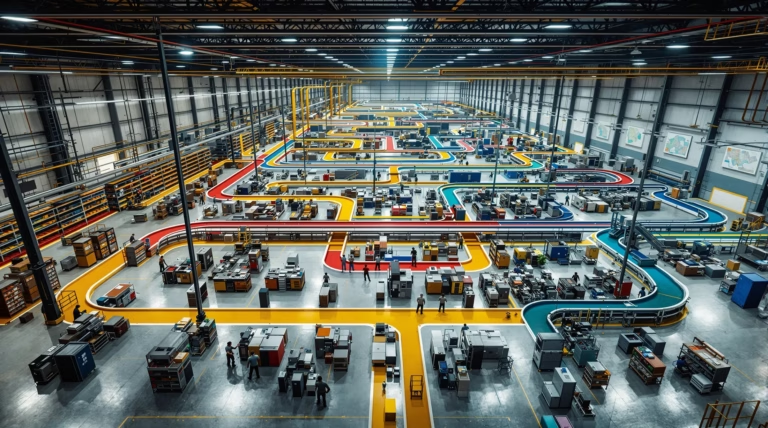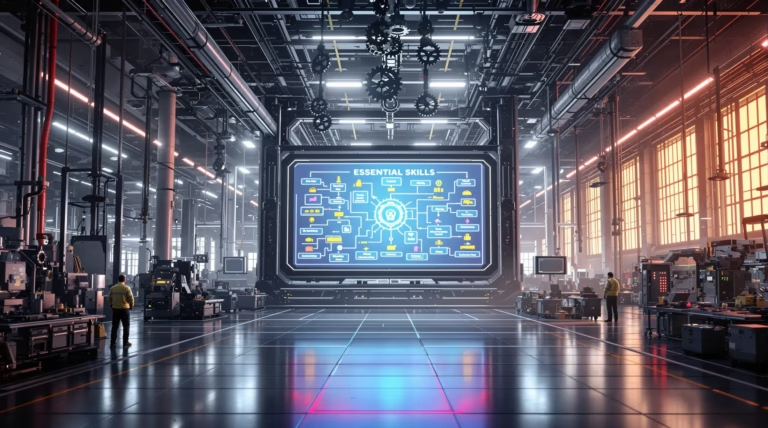Manufacturing Waste Reduction: 9 Essential Tips for Success
In today’s competitive manufacturing landscape, waste reduction has emerged as a critical factor for business success. Discover how implementing effective waste reduction strategies can transform your manufacturing operations, boost profitability, and contribute to environmental sustainability.
Understanding the Importance of Manufacturing Waste Reduction
Manufacturing waste reduction transcends environmental considerations to become a vital business strategy impacting operational efficiency and financial performance. When manufacturers eliminate non-value-adding processes and materials, they create leaner operations that optimize resource utilization while delivering superior results.
- Material scraps reduction
- Product defects minimization
- Unnecessary movement elimination
- Rework prevention
- Process optimization
A comprehensive approach to waste reduction transforms manufacturing processes from end to end. Forward-thinking manufacturers integrate waste reduction strategies into every operational aspect, enabling proactive control, limitation, auditing, and optimization throughout the production cycle.
The Environmental and Economic Benefits
The environmental impact of manufacturing waste reduction extends far beyond immediate operational improvements. By minimizing material waste, companies significantly decrease landfill volumes and reduce raw resource extraction demands.
| Benefit Category | Impact |
|---|---|
| Energy Optimization | 30-50% carbon footprint reduction through LED and HVAC upgrades |
| Production Costs | 15-20% decrease while increasing output capacity |
| Resource Efficiency | Improved material utilization and reduced waste disposal |
Regulatory Compliance and Corporate Responsibility
Manufacturing companies navigate an increasingly complex regulatory landscape regarding waste management and environmental impact. Proactive waste reduction strategies help manufacturers stay ahead of regulatory requirements, avoiding potential fines, production disruptions, and reputational damage.
Implementing Sustainable Manufacturing Practices
Sustainable manufacturing practices represent a fundamental shift in production facility operations, focusing on minimizing environmental impact while maximizing resource efficiency and economic performance. These approaches embed sustainability into the core business model, creating long-term value through reduced operational costs and enhanced competitiveness.
Adopting Lean Manufacturing Techniques
Lean manufacturing provides a systematic framework for waste elimination by focusing on customer value creation. This approach identifies eight distinct types of waste:
- Defects – reducing production errors by 25% through visual management
- Overproduction – eliminating unnecessary resource consumption
- Waiting – optimizing production flow
- Non-utilized talent – maximizing workforce potential
- Transportation – minimizing unnecessary movement
- Inventory excess – reducing storage and handling costs
- Motion waste – improving workplace ergonomics
- Extra processing – streamlining operations
Incorporating Recycling and Reuse
Strategic recycling and reuse programs transform waste into valuable resources through closed-loop systems that capture economic value while minimizing environmental impact. Modern manufacturers now integrate production processes that systematically categorize by-products and residual materials for potential reuse rather than disposal.
- Metal scrap reclamation – delivers 40-60% reduction in waste disposal costs
- Solvent distillation – enables material recovery and reuse
- Plastic regrinding – reduces raw material purchases by 10-30%
- Heat recovery systems – capture thermal energy for water heating and HVAC
- Water recycling loops – minimize intake and discharge volumes
Conducting a Comprehensive Waste Audit
A systematic waste audit establishes the foundation for effective manufacturing waste reduction. While internal audits provide value, partnering with professional waste auditing firms often reveals deeper insights and supports green certification efforts. The process begins by defining clear objectives and scope, engaging stakeholders across all organizational levels to gather diverse perspectives on waste generation.
Identifying Waste Sources and Types
| Waste Category | Examples |
|---|---|
| Material Waste | Scraps, off-cuts, excess materials |
| Production Waste | Defective products, packaging materials |
| Operational Waste | Lubricants, cleaning agents |
| Process Waste | Wasted motion, excessive processing, waiting time |
Analyzing Waste Data for Improvement
Effective waste data analysis requires establishing key performance indicators (KPIs) aligned with business objectives. These metrics provide a framework for monitoring and highlighting improvement areas.
- Waste volume per unit produced
- Disposal costs as percentage of production costs
- Recycling rate and material recovery
- Seasonal variations in waste generation
- Correlation between production volumes and waste outputs
Optimizing Supply Chain for Waste Reduction
Supply chain optimization represents a critical component in manufacturing waste reduction. By aligning procurement with customer demand, manufacturers can prevent excess inventory and costly shortages. Companies implementing optimized supply chains typically achieve 20-30% waste reduction while improving delivery reliability by 15-25%. This comprehensive approach addresses multiple waste vectors, from transportation efficiency to packaging optimization, creating value through enhanced environmental and operational performance.
Enhancing Supplier Collaboration
Effective supplier collaboration transforms traditional transactional relationships into strategic partnerships focused on mutual waste reduction goals. When manufacturers and suppliers share data, technologies, and best practices, they create synchronized processes that eliminate redundancies across organizational boundaries.
- Co-developing packaging specifications reduces material usage by 15-20%
- Regular supplier audits identify waste elimination opportunities
- Shared performance metrics drive continuous improvement
- Clear communication channels facilitate joint problem-solving
- Supplier scorecards integrate waste reduction with traditional metrics
Implementing Just-In-Time Inventory
Just-In-Time (JIT) inventory management revolutionizes material handling by delivering components exactly when needed in production. This sophisticated approach requires precise synchronization between production schedules and supplier deliveries, supported by real-time inventory management systems.
| JIT Implementation Benefits | Typical Results |
|---|---|
| Inventory Holding Costs | 40-60% reduction |
| Warehouse Space Requirements | 30-50% decrease |
| Material Utilization Rates | 20-30% improvement |
Improving Energy Efficiency in Manufacturing
Energy efficiency represents a cornerstone strategy in manufacturing waste reduction efforts, delivering both environmental sustainability and operational profitability. Systematic energy consumption reduction can decrease greenhouse gas emissions while cutting operational costs by 15-30% with proper implementation.
- Comprehensive monitoring systems track consumption patterns
- Regular energy audits identify improvement opportunities
- Clear performance metrics ensure team accountability
- Waste heat recovery systems capture and repurpose thermal energy
- Leadership commitment drives cultural change
Upgrading to Energy-Efficient Equipment
Modern production machinery offers 30-50% greater energy efficiency compared to decade-old equipment. Strategic equipment upgrades incorporate sophisticated energy management features that optimize consumption based on production needs.
- Variable frequency drives optimize motor performance
- Smart lighting solutions with occupancy sensors
- Advanced HVAC systems reduce facility-wide consumption
- Insulation improvements enhance existing equipment efficiency
- Reusable equipment reduces embedded energy waste
Utilizing Renewable Energy Sources
On-site renewable energy installations transform manufacturing operations by generating clean power directly where needed. This approach delivers 40-60% energy cost reductions over system lifetime while providing protection against market volatility.
| Renewable Strategy | Key Benefits |
|---|---|
| On-site Solar/Wind | Direct generation, eliminated transmission losses |
| Power Purchase Agreements | Competitive rates, long-term price stability |
| Battery Storage Systems | Peak production capture, demand management |







